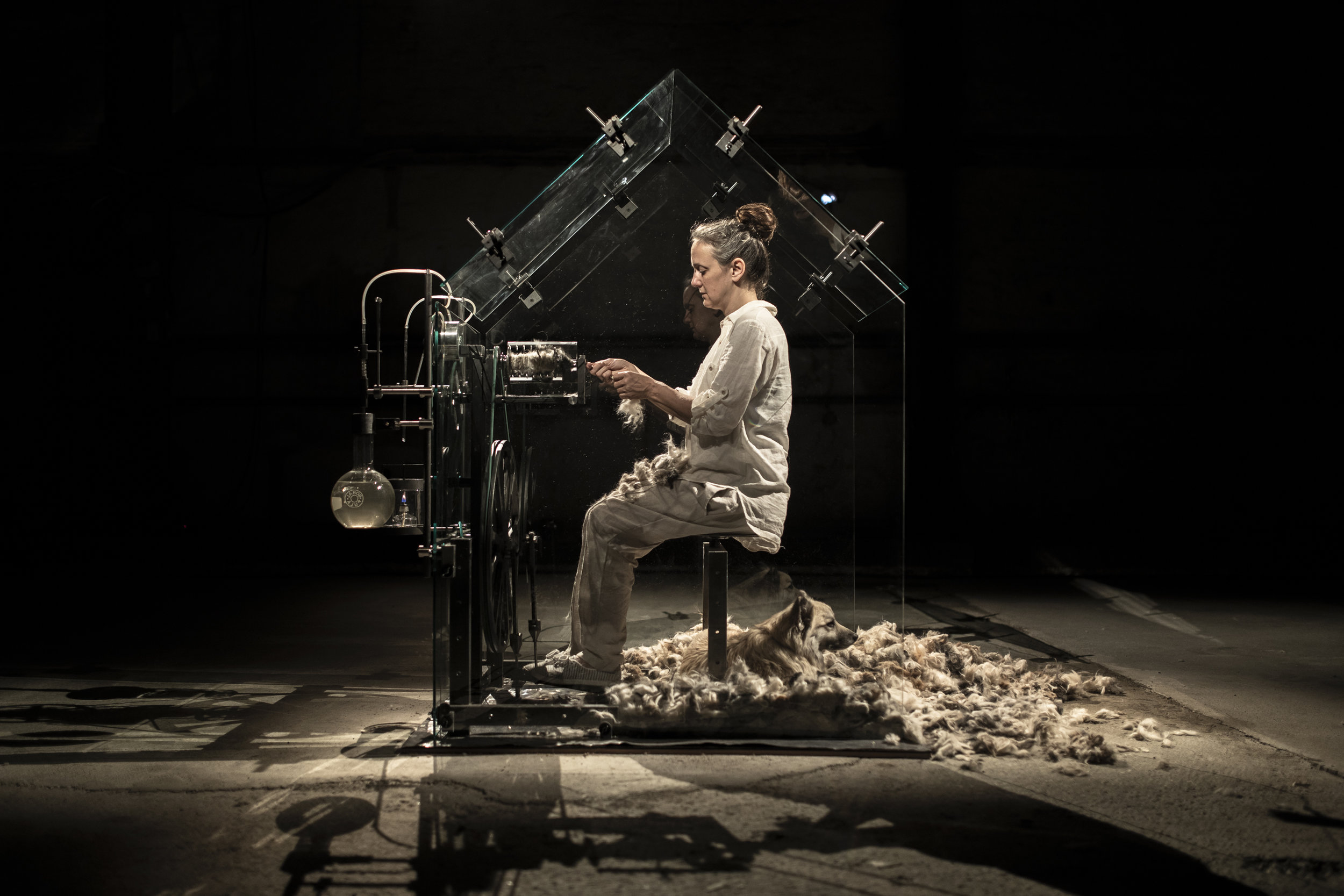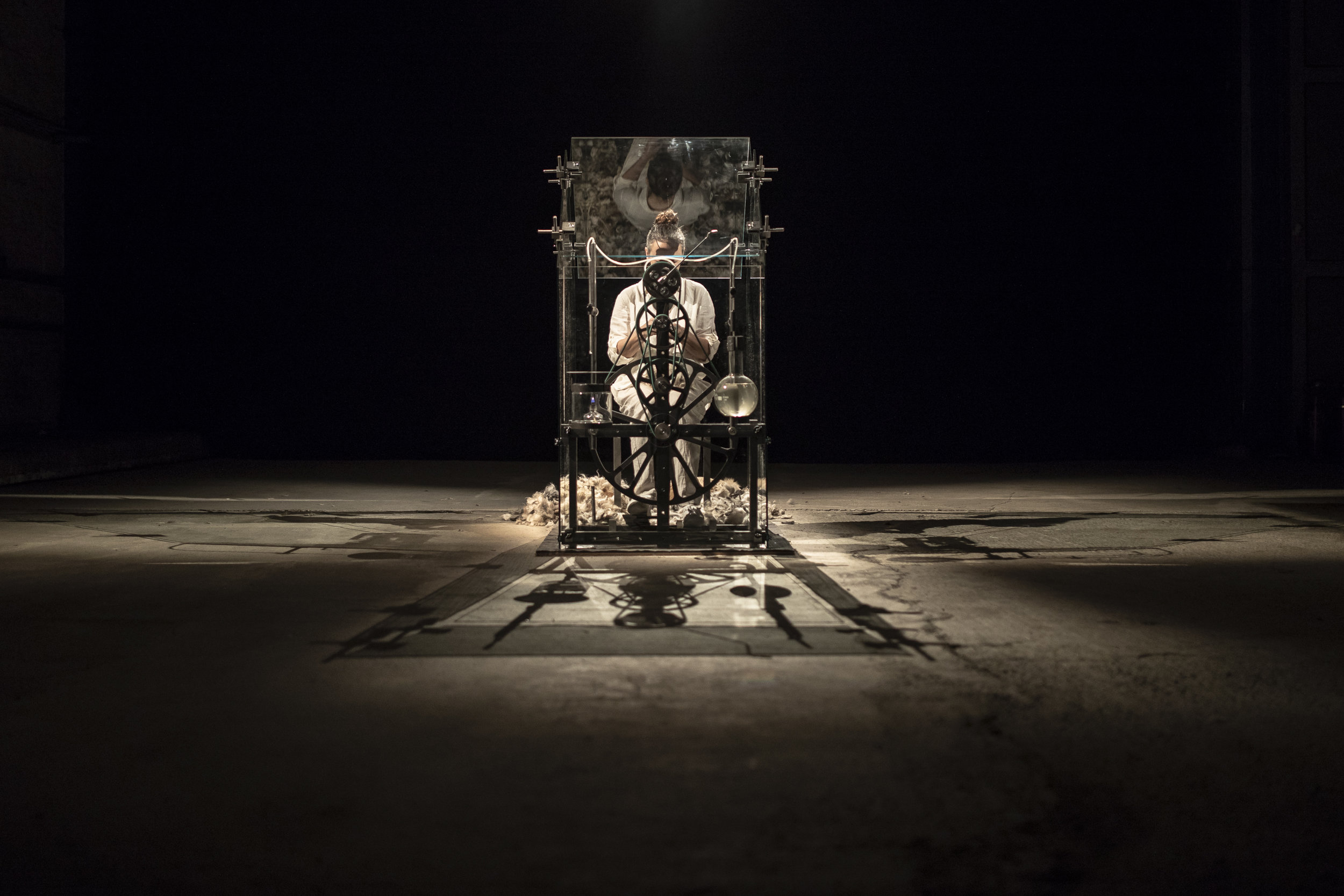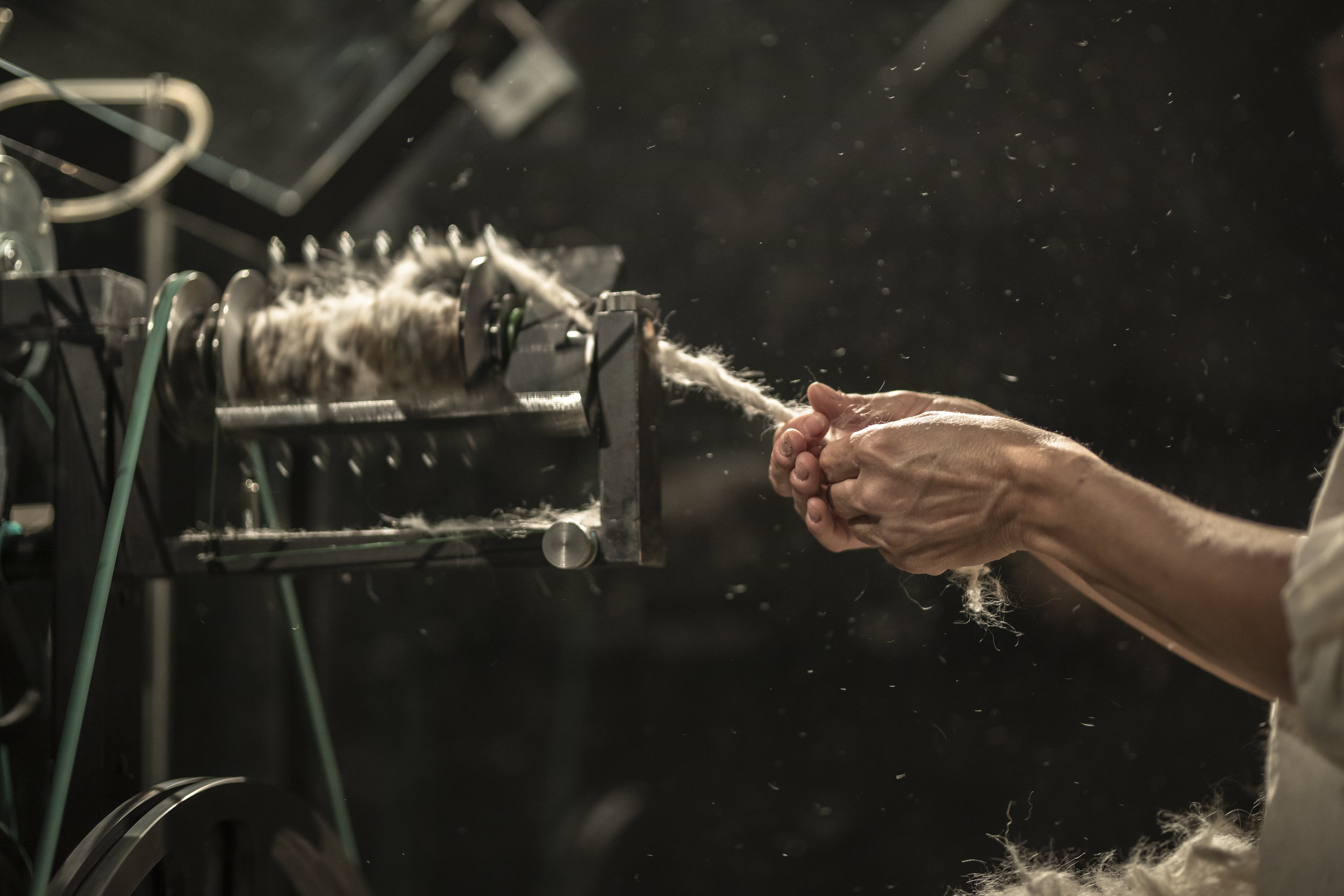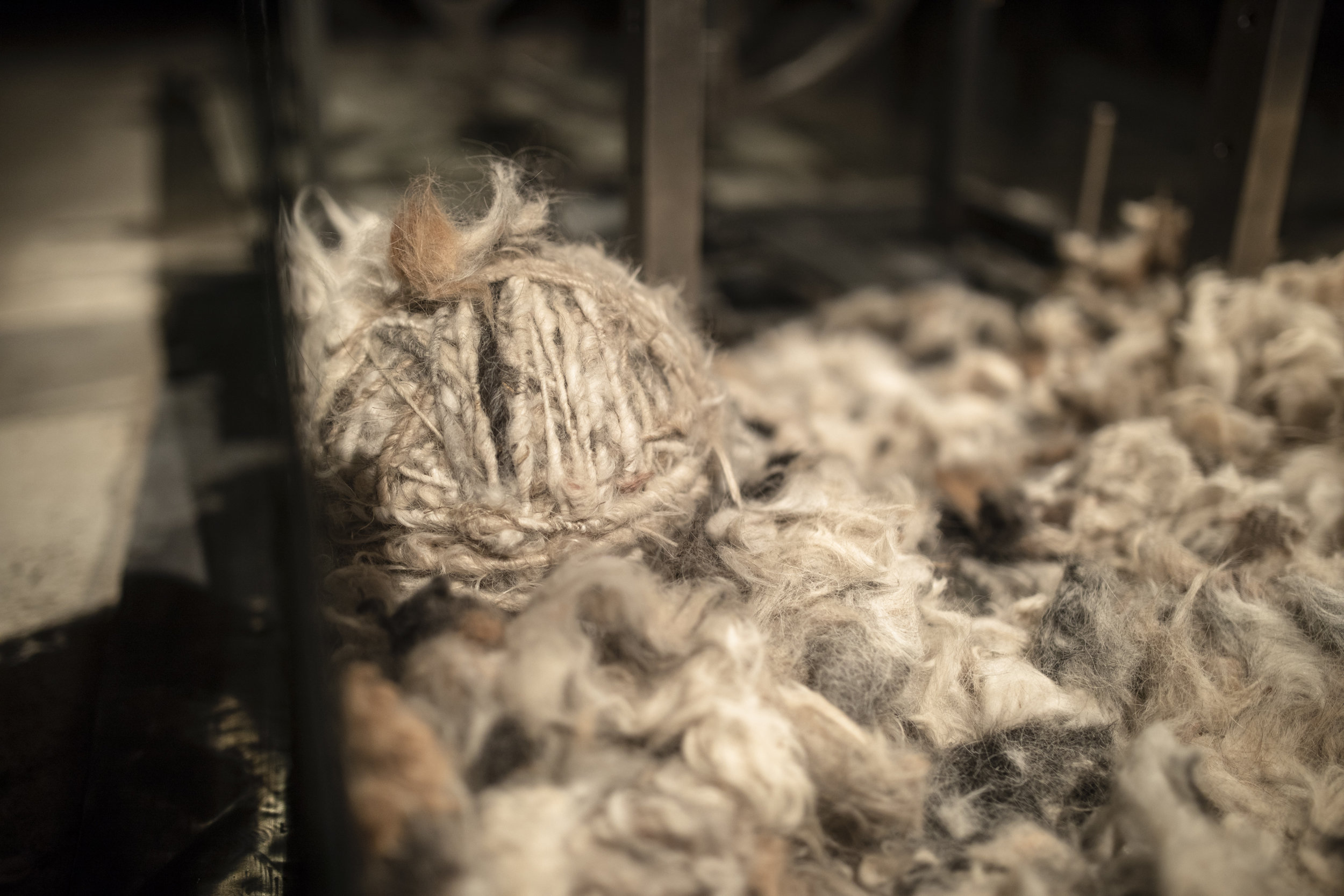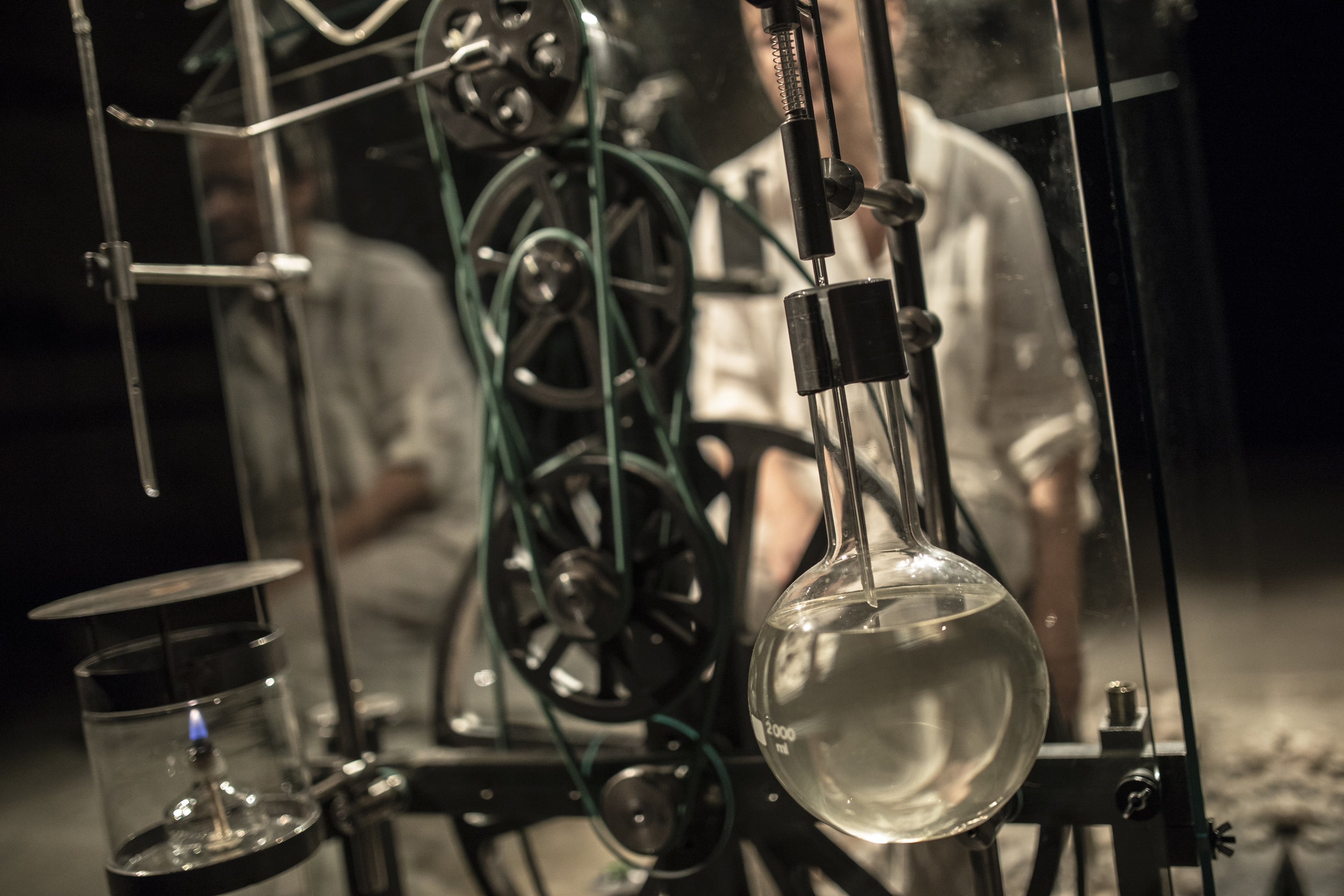Opus et Domus
2018
The absent intimacy of home in this durational performance emerges as a political stand in relation to the modern capitalist structure of work, in which home becomes the place of work again. This re-actualizes the archetypal forms of labour exploitation, semantics of materials and policy of corporeality as we know from the mythologies.
Opus et domus correlates to the Hybrid Family project in content and form. The service gesture of turning the spinning wheel involving the entire physical body objectivizes the female body as a means of production. This is increasingly apparent in the time of populism in which the significance of the nation increases, placing also great value on birth rate. Through such social regression the female body is often again sees as property of the state, law and ideology. This is why the artist reverted to this obsolete form of production in her performance, with the advanced technology of paralelly running peristaltic pumps of the laboratory, serving to underline the contrast to the symptom. Smrekar includes her Hybrid Family in this project by producing yarn from dog and human hair, spun into a social fabric that is not defined by technology but by the probability of creating a completely new hybrid relationship. The archetypal relationship of humans and dogs forming a hybrid community thus paraphrases Frans de Waal’s conclusion that “the roots of politics are older than humanity.”
Maja Smrekar, “Opus et Domus”, 2018 Heavenly Beings: Neither Human nor Animal, Museum of Contemporary Art Metelkova, Ljubljana.
Feminist artists have longed used traditional crafts to celebrate women’s labour. Maja Smrekar’s spinning wheel performance clearly references that tradition, but points to a different political interest. Inter-species kinship rather than feminist sisterhood animates Smrekar’s world. And it is a world in which death, as well as love, is the unifying factor.
Smrekar’s new work, Opus et Domus (work and home), premiered in May at the Click Festival for Contemporary Art, Science and Technology in Helsingør, and has recently been re-shown in Ljubljana. In both cases, the audience walks into a dark room, where Smrekar is spinning a thread made from dog and human hair. Like some steampunk Norn, the artist sits at a futuristic spindle made of chrome and steel, dressed all in white. At her feet lies a small dog, whose sharp barks occasionally rupture the silence. Clearly this piece invites no participation; it is a tableau vivant, from which respectful distance must be kept.
As visually striking as this ensemble might be, it is in the olfactory dimension that the emotional core of the piece lies. Smrekar’s spinning powers a pump, which causes a liquid to periodically drop onto a hot plate, vaporising it. This liquid is an odoriferous mixture, combining serotonin taken from the blood of the artist with that taken from her dog. Serotonin is a neuro-transmitter responsible for feelings of happiness. It plays a role in bonding between individuals. The musty smell that pervades the room, then, is the aromatic signature of Smrekar’s friendship with her dog. It is the smell of the substance that allows them to dwell together.
Smrekar’s works over the last fifteen years have mostly included some such biomedical element, thereby belonging squarely within the contemporary art genre known as sci-art. Last year, her opus K-9_topology received the Golden Nica award at Ars Electronica, the sector’s most prestigious award. Sci-art, it must be admitted, has suffered from a certain insularity within the artworld. Festivals like Ars Electronica, Click or Transmediale can feel like hobbyist fairs, with participants more excited by the technical functionality of each work, rather than by any artistic merit these may have. This is where Smrekar’s oeuvre has risen above the genre. Yes, she always includes a laboratory-based element: here, that is the serotonin mixture, the extraction and preparation of which is quite interesting. However, her performances are also bewitchingly intense, relying heavily on Smrekar’s shamanic charisma.
The endurance element is crucial here: Smrekar makes her tireless, repetitive movements with haunting concentration. Like feminist artists of the 1970s (such as Mierkle Ukele Laderman or Mary Kelly), Smrekar seems thereby to emphasise the toil involved in domestic and in emotional labour, in the spinning of the thread and in the dripping of the serotonin. Nevertheless, the piece reads less as an allegory of labour—the spinning wheel is, after all, a pre-industrial instrument that nobody today uses—than as an allegory of fate, of the Norns or the Moirai passing and cutting the thread of life. The drops of serotonin hit the hot plate with a regular hiss, like an implacable ticking of a clock. The time of this joint human-canine dwelling seems limited, and the substance that powers it is slowly running out.
In her Creaturely Poetics, Anat Pick has argued for an animal ethics based on a sense of shared vulnerability. While Pick traced her argument through works of literature and film (William Golding, Marie Darrieussecq, Werner Herzog), we might detect a similar logic in Smrekar’s performance art. This is perhaps even clearer in the opus for which Smrekar won the Golden Nica. In Ecce Canis (2014), I Hunt Nature and Culture Hunts Me (2014), Hybrid Family (2015/16) and ARTE-mis (2016/17), Smrekar attempted to create a family unit made up of herself and her dogs. The actions ranged from intense cohabitation, lying naked among dogs and wolves, to the act of freezing the reproductive cells taken from herself and from her dog, joining them in a state of cryogenetic death.
In these works, Smrekar never idealises the canine, nor the human. Attempts at coexistence can desperately misfire; pack hierarchies are maintained. In Opus et Domus, the dog is chained on a leash and the artist’s production of serotonin is as laborious as it is chillingly mechanical. The stuffy odour suggests the safety of a den, but equally speaks of oppression. If we should wonder what ethical picture follows from Smrekar’s work, the answer would also have to be complex. Despite nods to Donna Haraway in Smrekar’s texts, the artist’s performances are quite unlike the idealised picture of dog-human relations offered in Haraway’s The Companion Species Manifesto (2003). Haraway there extols such pleasant modern pursuits as dog agility training. These are described as a model of “significant otherness,” of mutual flourishing across species boundaries.
Smrekar seems less interested in spelling out utopias. In her works, cohabitation is rarely possible without exploitation. Yet, like in the untiring spinning of wool in Opus et Domus, what does remain is a desperate attempt to create a joint home. This is a goal that, on the planetary level, may already be beyond our reach.
———
Vid Simoniti
Collaborators: Lovrenc Košenina, Anže Sekelj, Michaela Selmani, Gia Gruden, Bojana Ažman
Co-produced by: Click Festival / Kulturvaerftet (Denmark) and Kapelica Gallery/Kersnikova Institute (Slovenia)
Supported by: Bikuben Foundation, Danish Arts Council, Ministry of Culture of the Republic of Slovenia, Department of Culture of the Municipality of Ljubljana
